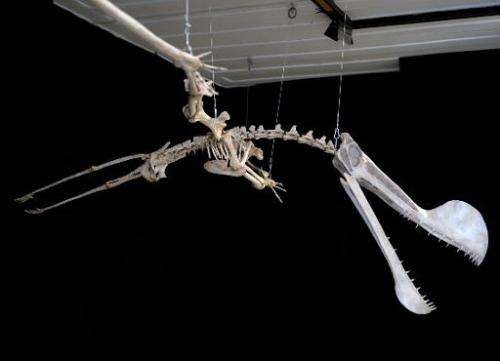Pelican-like pterosaur enters record books

Fossil hunters have found the remains of a pterosaur whose jaw suggests the flying reptile skimmed fish from surface water and stored the prey in a pelican-like throat pouch, they said on Thursday.
The unusual creature has been named Ikrandraco avatar—a tribute to the pterosaur-like flying creatures, "ikran," in James Cameron's sci-fi movie Avatar.
The monicker incorporates "draco," from the Latin for dragon.
Two incomplete specimens were found near each other in the Jiufotang geological formation of northeast China, part of a treasure trove of fossils from the Early Cretaceous era some 120 million years ago.
Ikrandraco had a very flat and elongated skull, and a distinctive blade-like crest under the tip of its lower jaw.
From this crest, which had a hook-like appendage, hung an extendable throat pouch, the authors suggest.
This feature had been tentatively proposed for pterosaurs, based on impressions of soft skin folds found in some fossil specimens.
But until now, it had never been confirmed. Such throat pouches are familiar to us today in pelicans.
"We propose that this pterosaur fed on fishes from nearby lakes by flying low over the water and capturing its prey by lowering the mandible in the water," says the study.
The pouch would have allowed the pterosaur to store its catch to enable it to continue hunting, or possibly to help it expel any water scooped up with the prey.
Close cousins of dinosaurs, pterosaurs lived from about 225 million to 65 million years ago. So far, more than 100 species have been discovered, including giants with a wingspan of 13 metres (42 feet).
The research, published in the journal Scientific Reports, was led by Xiaolin Wang of the Chinese Academy of Sciences in Beijing and Alexander Kellner of Brazil's National Museum in Rio de Janeiro.
Journal information: Scientific Reports
© 2014 AFP



















